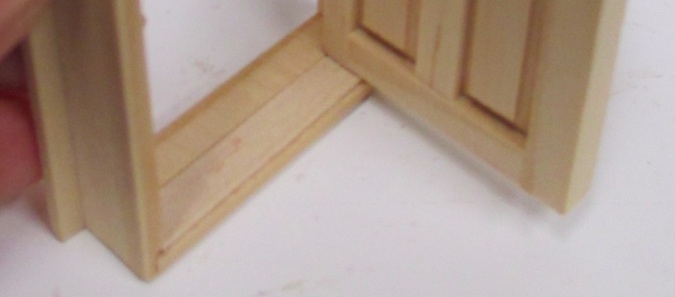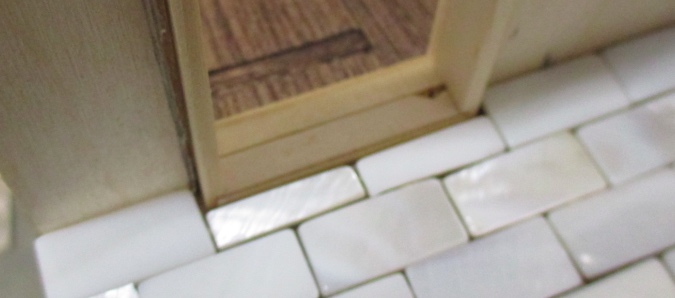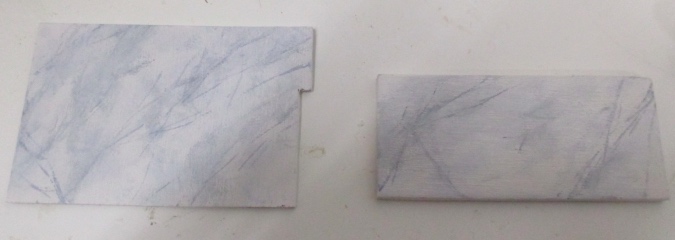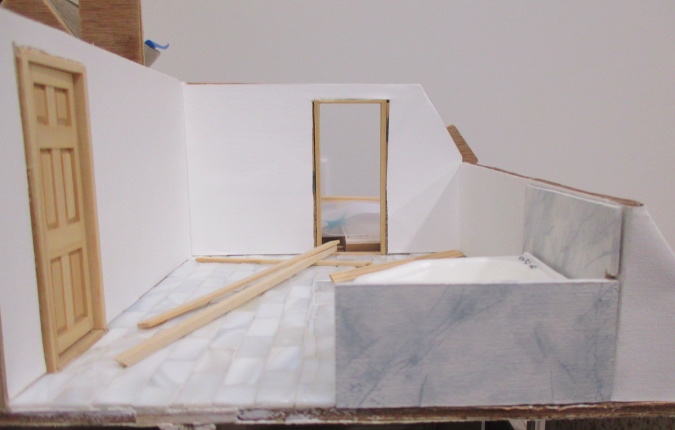The Victorianna’s master bathroom is a jack-and-jill bath with one door leading to the master bedroom and one door to the nursery. Because the real tile I’m using is thicker than usual dollhouse flooring, I had to modify the doors to enable them to swing over the tile.
The threshold of Houseworks doors is higher on one side than the other, to prevent the door from swinging in one direction. This way the door always opens in.

I cut down the bottom of the door so it’s short enough to swing over this lip. Then I re-hinged the door so the pins are closer to the middle of the door. Finally I added a piece of scrap wood to the lower side of the threshold, so now the whole threshold is the same height. As a result, the bathroom doors will swing both ways — into the bathroom or into the bedroom. It’s a little funky but it’s the best I could come up with.

(Why not just turn the doors around so the high part of the threshold is against the tile in the first place? To do that I would have needed to have the doors in place when I laid the floor — with the tile glued in, it was too tight a fit to wedge the doors into the door holes from the bathroom side. For the doors to be in place when the tile was glued in, the wallpaper would have needed to be up, and I didn’t want to wallpaper before I finished the tile, for fear of getting grout on the walls. Which came first, the chicken or the egg?)
Once I got the nursery door mocked up so it would swing properly, I added shims to the trim on the nursery side and set it in place to see how far the door sticks into the bathroom. I’ll also add shims to the trim on the bathroom side, so the trim will be about the same size on each side and won’t look funny when you view the door from the side. This is better explained in an earlier post about the downstairs bathroom door.

With the door shimmed, I’m able to see how much it sticks into the bathroom. This was necessary so I knew how much to cut the two tiles directly in front of the door.

These were very hard to cut, so it’s a good thing I only needed to do two of them! I used various sharp tools until I managed to cut all the way through, and then sanded for sort of straight lines. Turning the tiles with the cut ends facing other tiles rather than putting the cut ends against the door makes them look neater than they really are.

Finally, time to grout! I used up my sand grout a while ago and didn’t want to use the dark gray mortar I’ve been using for bricks, thinking that would call attention to the inconsistent grout lines and would just be too dark. So I bought a tub of white mosaic grout at the hobby store, intending to add a little bit of gray so it wouldn’t be stark white. I remembered that I’d planned to do that about thirty seconds after I started spreading grout on the tiles.

Oh well. I went ahead with the plain white.

Here it is with the mess wiped off. I still think choosing white over dark gray was the right call, but it’s a little too bright alongside the blue/gray tint on the mother of pearl tiles.

I mixed up a gray wash (paint watered down) and tried it out, wiping it off soon after wiping it on so it wouldn’t stick to the tile. In this photo the left is virgin grout, the middle has the wash applied, and the right has the wash with the excess wiped off. In some spots it just didn’t want to soak into the grout even after I applied and reapplied, but as far as toning down the bright white, it gets the job done.

With the grout finished, I glued in the wall. The ceiling is just set in place here, to help hold it in while the glue dries. Geoff helped me cut holes for the giant skylights, which make such a difference in lighting up the room.

Next, wallpaper. I haven’t been able to get any more of the pale pink I’ve been using throughout the house, or of the tan I used in the other bathroom. This is a bright white, canvas-like scrapbook paper that has a similar texture to those two papers.

I want to do the tub surround, shower surround, and sink countertop in Carrara marble. I’ve been looking around for paper I can use but haven’t been able to get to Michaels or the dollhouse store to see anything in person. After some bad experiences with printies, I don’t want to print out a marble pattern. So I decided to try painting a marble effect and see if I can do a decent job.

I haven’t decided if I like these enough to use them. If I decide to stick with this I’ll have to paint more for the shower and sink, so I’ll document how I did it then, but the basic process was:
- White base coat
- Splotched-on gray and blue with a dry brush which looked AWFUL
- Painted over the splotches with another coat of white, which accidentally resulted in a shadowy effect that actually looks marble-like
- Added blue and gray “veins” by pressing on a piece of painted thread in diagonal branching patterns
- Lightly splotched on some light gray around the veins with a dry brush
- Painted over the whole thing with a white wash (the same white paint as the base coat, watered down)

I messed up the notch where the two pieces meet, so even if I do decide to use this technique, I’ll have to redo the larger piece. That piece is too small to be repurposed for the sink or shower, but I can hold onto it for some future sink or island countertop.

What do you think, dear readers — does it look like marble? Any suggestions for making it look more like marble? I’ve read about using a feather for the veining but I don’t have any feathers handy.
 Emily is a freelance writer, miniaturist, and adventure game enthusiast.
Emily is a freelance writer, miniaturist, and adventure game enthusiast.


Absolutely perfect! So good of you to share your thoughts and experiments with those of us who are in the planning stages!
It looks great! I always love watching your beautiful houses progress.